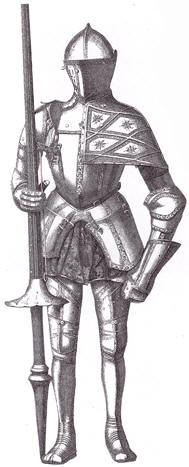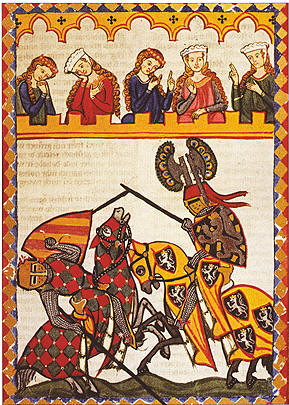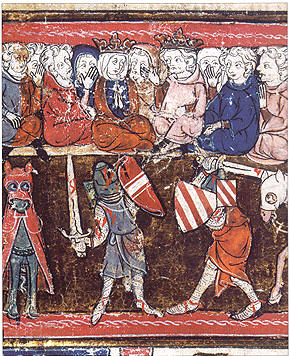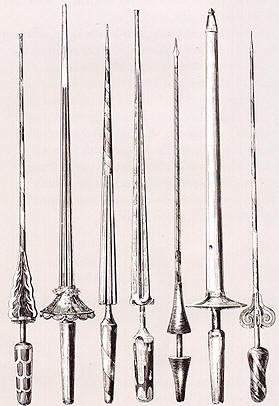Medieval and Renaissance Jousts
Jousts and tournaments took the
form of individual combat between armored knights,
mounted or on foot, using lances, swords, axes and
maces. Jousting was first practiced in the early
Middle Ages. During these colorful public events,
two knights fought to enhance their martial
reputation. The melee, a tournament (or tourney),
provided the audience with the spectacle of many
knights involved in mass trials by combat. Compared
with warfare proper, this form of organized
“entertainment” was only one step away from the real
thing.
Origins of the
Tournament
 The
first written record of a formulated set of
tournament rules is usually credited to a Frenchman,
Geoffroi de Purelli, in 1066. Unfortunately, his
guidelines were of limited use to him as he was
killed at the very tournament for which he had
composed the rules. Despite this early setback, the
popularity of jousting was firmly established in
western Europe by the 13th century and it continued
as a public sport well into the 1600s. The
first written record of a formulated set of
tournament rules is usually credited to a Frenchman,
Geoffroi de Purelli, in 1066. Unfortunately, his
guidelines were of limited use to him as he was
killed at the very tournament for which he had
composed the rules. Despite this early setback, the
popularity of jousting was firmly established in
western Europe by the 13th century and it continued
as a public sport well into the 1600s.
RIGHT:
A
knight with jousting lance, c.1500. His plate
armor includes an extra protective layer near his
vulnerable left side.
Military Service in the Medieval Period
Medieval knights
were obliged to provide military service to their
king, lord or liege on a regular basis. Warfare
during this period, although perhaps exciting to a
young knight on his first campaign, was, for most of
those involved, extremely unpleasant. Living
conditions were usually poor and, if the knight was
not killed or badly wounded in battle, the
combination of disease or hunger would normally
carry him away. But there could be an opportunity
for redemption amidst this state of wretchedness. By
showing valor and courage on the battlefield, he had
the opportunity to establish a martial reputation
with the consequent possibility of great financial
and social rewards from his master, or even the
king.
 On
the other hand, equivalent fame and fortune,
combined with regular practice in the use of
weapons, could also be gained in peacetime and
without embarking on a long and possibly fatal
campaign of war. This alternative avenue was to be
found in the joust and tournament. On
the other hand, equivalent fame and fortune,
combined with regular practice in the use of
weapons, could also be gained in peacetime and
without embarking on a long and possibly fatal
campaign of war. This alternative avenue was to be
found in the joust and tournament.
The Individual
Joust
A joust was a
horseback encounter between two knights with lances.
The object was to unhorse the opponent. If a
combatant struck either rider or horse with his
lance, he was automatically disqualified. This was
known as “tilting” If the opponent was not unhorsed
but a clean hit was made to the centre or “boss” of
his shield, points would be awarded.
ABOVE:
A
knight is unhorsed with a jousting lance. The
illustration is taken from the Codex Manesse
by Waither von Klingen, Zurich, c.1310—40.
The
Melee or Tourney
 Taking
the form of massed trials by arms in a public arena,
the melee or tourney was a popular part of the
tournament in the 12th and 13th centuries (jousting
became popular later on). It was a savage and brutal
fixture, with many lives lost and serious injuries
sustained. Upon hearing the call to charge, rival
knights rode or ran onto the tournament field and
proceeded to unhorse or attack their designated
opponents with a selection of weapons, including
broadsword, war axe, club or mace. Taking
the form of massed trials by arms in a public arena,
the melee or tourney was a popular part of the
tournament in the 12th and 13th centuries (jousting
became popular later on). It was a savage and brutal
fixture, with many lives lost and serious injuries
sustained. Upon hearing the call to charge, rival
knights rode or ran onto the tournament field and
proceeded to unhorse or attack their designated
opponents with a selection of weapons, including
broadsword, war axe, club or mace.
RIGHT:
In
this French 14th-century illumination the knight
Lancelot is depicted in single combat, watched by
King Arthur and Guinevere.
In some competitions, the melee was more organized,
with combat restricted to a series of three strokes
per weapon: for example, three tilts of the lance or
three strokes of the sword, and the same for both
battle-axe and mace. To actually kill an opponent
during a tournament was considered morally wrong,
although the ferocity of the combat sometimes
inevitably led to fatalities.
The Jousting
Lance
 Jousting
lances were made of solid oak and it would have
required considerable strength, force and accuracy
to unseat an opponent. It would certainly have taken
a significant strike to shatter a lance. Knights
practiced their technique against a specially
constructed target, or quintain, a life-sized
re-creation of an opponent’s lance, helmet and
shield. In modern-day re-creations of the joust, a
lightweight, wooden lance is used in order that it
can break more easily and so lessen the impact on an
opponent. Jousting
lances were made of solid oak and it would have
required considerable strength, force and accuracy
to unseat an opponent. It would certainly have taken
a significant strike to shatter a lance. Knights
practiced their technique against a specially
constructed target, or quintain, a life-sized
re-creation of an opponent’s lance, helmet and
shield. In modern-day re-creations of the joust, a
lightweight, wooden lance is used in order that it
can break more easily and so lessen the impact on an
opponent.
Two types of horses were used during the joust.
Warmblood chargers were selected for their stamina
and quickness in the charge, whereas heavy warhorses
or coldblood destriers were chosen for their large
bulk, which made them deliberately slower but able
to pack a heavier punch upon contact. Horses were
trained to canter at an ambling pace to give their
riders stability and enable them to focus and aim
better with their lances.
ABOVE:
A
selection of jousting lances. At the end of each
lance was a coronal (crown-shaped metal cap)
consisting of three or more metal prongs, designed
to catch onto the opponent’s shield.
|